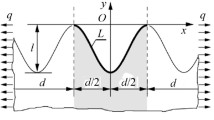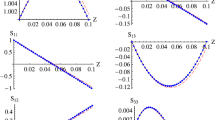We construct a theory of plates loaded only on their sides by loads parallel and symmetric to the median surface. We use the general representation of three-dimensional stress-strain state and exactly satisfy the trivial boundary conditions on the plane surfaces of the plate. The numerical analysis of the three-dimensional stressed state of the plate is reduced to the determination of its two-dimensional state under the assumption that the normal stresses perpendicular to the median surface are negligible. The displacements and stresses are expressed via two two-dimensional harmonic functions. We obtain the homogeneous solutions and develop a numerical-analytic algorithm for the solution of the boundary-value problems posed for rectangular plates.
Similar content being viewed by others
Avoid common mistakes on your manuscript.
Plates loaded only on their sides by loads parallel and symmetric to the median surface are widely used in building and engineering structures [1,2,3,4,5,6,7]. The stressed state of thin plates is, as a rule, determined by using the equations of the plane problem of the theory of elasticity [2,3,4]. For thick plates, it is customary to use the homogeneous solutions and the symbolic method [5, 8], harmonic and biharmonic functions [2,3,4], hypothesis on the behavior of normal to the median surface [1, 8], or expansions of the Papkovich–Neuber representation in the variable normal to the median surface [5, 9].
Statement of the Problem and Its Solution
Consider a three-dimensional static problem of the theory of elasticity for a plate with constant thickness h whose median surface occupies a domain S with contour L and coincides with the plane Oxy of a Cartesian coordinate system: x 1 = x, x 2 = y, x 3 = z. The general stressed state of the plate can be split [10] into the states of bending and symmetric pressure:
where u i are displacements in the directions of the corresponding axes of the Cartesian coordinate system.
We now consider a special case of the second problem where the plane surfaces of the plate \( \left(z={h}_j,j=\overline{1,2},\kern1em {h}_1=h/2,\kern1em {h}_2=-h/2\right) \) are free of normal and tangential loads and its sides (lateral surfaces) are subjected to the action of loads symmetric and parallel to the median surface S :
For the solution of the problem, we use the general representation of the equations of the theory of elasticity [11] and write the components of the vector of displacements as follows:
where P = zΦ + Ψ is a biharmonic function, Φ , Ψ , and Q are harmonic functions called the functions of displacements, and ν is Poisson’s ratio. The function P satisfies the equation
where
is the two-dimensional Laplace operator. We now write the expressions for the normal stresses
and for the tangential stresses
whereG = E/2(1 + v) and E are, respectively, the shear and Young moduli. The sum of normal stresses is equal to \( -2E\frac{\partial \Phi}{\partial z} \).
Relations (1) and (2) imply that P and Q are even functions of the variable z and the function Φ is odd. From the symmetry of loads, we get the conditions imposed on the functions of displacements on the outer plane surfaces of the plate:
Here, the signs “+” and “–” describe the boundary values of the corresponding functions on the upper z = h 1 and lower z = − h 1 surfaces of the plate. Hence, the conditions imposed on the lower surface can be expressed via the functions defined on the upper surface.
In view of relations (4)–(6), we can write the following boundary conditions for the surfaces of the plate free of loads:
Equations (7) yield the following conditions of harmonicity:
In view of the fact that the normal stresses σ z are insignificant under the indicated loading of the plate, integrating along the Oz -axis, we find
Substituting relation (9) in the first equation in (8), we obtain
By using relation (9), we can simplify the second and third equations in (7) as follows:
We now construct a two-dimensional theory of symmetrically loaded plates. For this purpose, we substitute the three-dimensional stresses (4) and (5) in the known expressions for the normal and tangential forces [1, 2, 4]. Integrating these expressions, we get
where
In view of Eqs. (3), (9), and (10) and the harmonicity of the functions of displacements, we can now deduce the following key equations of the theory of plates:
where Φ+ and \( \frac{\partial {Q}^{+}}{\partial z} \) are harmonic functions and \( \tilde{P} \) and \( \tilde{Q} \) are biharmonic functions. Relations (11)–(13) are equivalent to the well-known balance equations for the plate [1, 2, 4] formulated in terms of forces. The general solution of the harmonic equation (10) takes the form
where φ is an unknown harmonic function. By using formula (14) and relation (11), we get
In view of relations (14) and (15), the general solution of Eqs. (13) takes the form
where
C(x) is an unknown function determined from the condition of harmonicity of the function φ1, and g j are harmonic functions. These functions can be represented in the form
where φ and ψ are harmonic functions.
We now substitute functions (14), (16), and (17) in relation (12). In this case, forces (12) can be represented via the functions introduced above:
Hence, the function φ does not appear in representation (18) and can be neglected. Relation (17) can be simplified to the form
We now introduce a biharmonic function U by the formula
Then relations (18) yield the well-known formulas for stresses from the plane problem of the theory of elasticity.
We now find the stresses in the plate by dividing the corresponding forces (18) by the thickness of the plate h . In view of relations (2), (7), and (9), we can find the transverse displacements and strains on the lateral surfaces of the plate:
For a thin plate, we get the dependence
in agreement with the three-dimensional theory of elasticity.
Since all relations of the theory of elasticity are exactly satisfied, the displacements and strains can be found as a result of averaging of relations (2):
Hence, the displacements in the directions of the Ox- and Oy-axes coincide with the averaged displacements of the three-dimensional theory of elasticity.
Note that forces (18) and displacements (19) are expressed via two harmonic functions ϕ and ψ of displacements of the plane problem. We now present their expressions for the known three-dimensional stressed states of the plate in the case of uniform tension–compression by loads σ0 in the direction of the Ox-axis:
In the case of uniform shear by tangential loads τ0 , we get φ = 0 and
Consider a rectangular plate Π = {(x, y) ∈ [0, a] × [−b, b]} whose lateral sides y = ± b are free of loads, i.e.,
On the sides perpendicular to these sides, we specify certain known loads σ g,m (y) and τ m (y):
where
The homogeneous solutions (eigenfunctions) that describe even normal stresses (about the Oy-axis) and odd tangential stresses and identically satisfy condition (20) can be constructed in the form of the sum of series in eigenvalues (as in [12]):
where α = x/a , γ = y/b , N is a given natural number, c = a/b , μ k , Re(μ k ) > 0, are the first N eigenvalues (the roots of the equation sin (2μ) + 2μ = 0),
g k are complex coefficients, θ(μ k , α) = exp(−cμ k α) , θ(μ k + N , α) = exp(cμ k (α − 1)), and \( {\upmu}_{k+N}={\upmu}_k,k=\overline{1,N} \).
Substituting the functions of displacements (22) in relation (18), we find the stresses and reduce conditions (21) to the following compact system of four equations:
where M = 4N, c k = Reg k , c 2N+k = Im g k ,\( k=\overline{1,2N} \), and \( {A}_k^m\left(\upgamma \right) \) are known functions.
We now apply the numerical-analytic method developed in [10, 12, 13]. Moreover, in order to satisfy the boundary conditions, we find the minimum F(N) of the generalized quadratic form
whose coefficients can be found analytically.
Lemma 1
[10]. The function F(N) is unknown and nonincreasing.
Theorem 1.
If the loads σ m (γ ) and τ m (γ ) are continuous and there exists N such that F(N) < ε2/4 for any ε > 0, then the stresses given by the functions \( \upvarphi =\underset{N\to \infty }{\operatorname{lim}}{\upvarphi}_N \) and \( \uppsi =\underset{N\to N}{\operatorname{lim}}{\uppsi}_N \) satisfy the boundary conditions ( 23 ) in the norm C[0,1] and describe the stressed state of the rectangular plate.
The proof of the theorem is based on equality (24) and known results from [13]. Note that the functional used to construct the generalized quadratic form is not bilinear. However, the value of F(N) tends to zero as N increases and serves as the estimate of convergence and accuracy of the solution.
Conclusions
On the basis of the three-dimensional theory of elasticity, without using the hypotheses of absence of the tangential stresses in the middle of the plate, we develop a two-dimensional theory of thin and thick plates loaded only on the lateral sides by loads symmetric about the median surface and parallel to this surface. It is shown that the obtained stresses and displacements are exactly equal to the corresponding averaged stresses and displacements of the three-dimensional theory of elasticity. Moreover, the obtained relations yield representations of stresses from the plane problem of the theory of elasticity. The proposed theory of plates is used for the construction of countable collections of homogeneous solutions and formulation of the criteria according to which their finite sum approximates the stress-strain state of the plate.
References
S. A. Ambartsumyan, Theory of Anisotropic Plates: Strength, Stability, and Vibration, Hemisphere, New York (1991).
S. P. Timoshenko and S. Woinowsky-Krieger, Theory of Plates and Shells, McGraw-Hill, New York (1959).
V. V. Panasyuk, M. P. Savruk, and A. P. Datsyshin, Distribution of Stresses Near Cracks in Plates and Shells [in Russian], Naukova Dumka, Kiev (1976).
L. H. Donnell, Beams, Plates, and Shells, McGraw-Hill, New York (1976).
A. S. Kosmodamianskii and V. A. Shaldyrvan, Thick Multiply Connected Plates [in Russian], Naukova Dumka, Kiev (1978).
A. K. Noor, “Bibliography of monographs and surveys on shells,” Appl. Mech. Rev., 43, No. 9, 223–234 (1990).
H. Kobayashi, “Survey of books and monographs on plates,” Mem. Fac. Eng. Osaka City Univ., 38, 73-98 (1997)
V. A. Shaldyrvan, “Some results and problems in the three-dimensional theory of plates (review),” Prikl. Mekh., 43, No. 2, 45–69 (2007); English translation : Int. Appl. Mech., 43, No. 2, 160–181 (2007).
W. Wang and M. X. Shi, “Thick plate theory based on general solutions of elasticity,” Acta Mech., 123, 27–36 (1997).
V. P. Revenko, “Reduction of a three-dimensional problem of the theory of bending of thick plates to the solution of two twodimensional problems,” Fiz.-Khim. Mekh. Mater., 51, No. 6, 34–39 (2015); English translation : Mater. Sci., 51, No. 6, 785–792 (2015).
V. P. Revenko, “Solving the three-dimensional equations of the linear theory of elasticity,” Prikl. Mekh., 45, No. 7, 52–65 (2009); English translation : Int. Appl. Mech., 45, No. 7, 730–741 (2009).
V. P. Revenko, “Development of the spectral Sturm–Liouville method for the solution of a boundary-value problem for the biharmonic equation,” Nelin. Kolyv., 6, No. 3, 368–377 (2003); English translation : Nonlin. Oscillat., 6, No. 3, 361–370 (2003).
V. N. Bakulin and V. P. Revenko, “A numerical-analytic method for finite bodies in the numerical analyses of a cylindrical orthotropic shells with rectangular holes,” Izv. Vyssh. Uchebn. Zaved., Mat., No. 6, 3–14 (2016).
Author information
Authors and Affiliations
Corresponding author
Additional information
Translated from Fizyko-Khimichna Mekhanika Materialiv, Vol. 52, No. 6, pp. 63–68, November–December, 2016.
Rights and permissions
About this article
Cite this article
Revenko, V.P., Revenko, A.V. Determination of Plane Stress-Strain States of the Plates on the Basis of the Three-Dimensional Theory of Elasticity. Mater Sci 52, 811–818 (2017). https://doi.org/10.1007/s11003-017-0025-7
Received:
Published:
Issue Date:
DOI: https://doi.org/10.1007/s11003-017-0025-7




